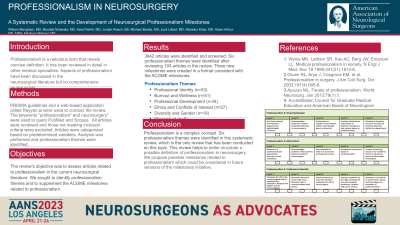A Systematic Review of Professionalism in Neurosurgery and the Development of Neurosurgical Professionalism Milestones
Friday, April 21, 2023

.jpg)
William Mangham, MD
Resident
University of Tennessee/Semmes-Murphey Clinic
Memphis, Tennessee, United States
ePoster Presenter(s)
Introduction: The neurosurgical literature contains work on various aspects of professionalism but currently lacks a comprehensive review of professionalism in neurosurgery. There is no consensus definition of neurosurgical professionalism despite the inclusion of professionalism into the Accreditation Council for Graduate Medical Education (ACGME) neurosurgery training milestones. We aim to broadly define pillars of professionalism in the context of neurosurgical practice and training.
Methods: A systematic review was conducted in accordance with Preferred Reporting Items for Systematic Reviews and Meta-Analyses (PRISMA) guidelines using the Rayyan web-application for systematic reviews. PubMed MEDLINE (National Library of Medicine) and Scopus (Elsevier) were queried using the keywords “professionalism” and “neurosurgery.” Articles were screened for inclusion by two independent reviewers. We then analyzed these articles to develop potential elements of professionalism.
Results: 3,704 unique articles were identified, and 257 articles were included after screening. There were seven broad pillars of neurosurgical professionalism found in the articles. These themes were professional development (22.6%), burnout/wellness (21.4%), professional identity (20.2%), ethics (14%), misconduct (8.9%), diversity/gender (7.4%), and surgical excellence (5.4%). Papers included ranged in publication dates from 1975 to the present. The topic of burnout became popular starting in 2013. Papers regarding professionalism in neurosurgery have become more common with each passing year. Based on these data a set of neurosurgical professionalism milestones is proposed.
Conclusion : The concept of professionalism in neurosurgery resists a concise definition. We performed the first systematic review of professionalism in neurosurgery and identified seven pillars of neurosurgical professionalism and defined a set of a neurosurgical professionalism milestones based on this data. These pillars may be useful to guide future organizational professionalism policies or in the development of future ACGME training milestones.
Methods: A systematic review was conducted in accordance with Preferred Reporting Items for Systematic Reviews and Meta-Analyses (PRISMA) guidelines using the Rayyan web-application for systematic reviews. PubMed MEDLINE (National Library of Medicine) and Scopus (Elsevier) were queried using the keywords “professionalism” and “neurosurgery.” Articles were screened for inclusion by two independent reviewers. We then analyzed these articles to develop potential elements of professionalism.
Results: 3,704 unique articles were identified, and 257 articles were included after screening. There were seven broad pillars of neurosurgical professionalism found in the articles. These themes were professional development (22.6%), burnout/wellness (21.4%), professional identity (20.2%), ethics (14%), misconduct (8.9%), diversity/gender (7.4%), and surgical excellence (5.4%). Papers included ranged in publication dates from 1975 to the present. The topic of burnout became popular starting in 2013. Papers regarding professionalism in neurosurgery have become more common with each passing year. Based on these data a set of neurosurgical professionalism milestones is proposed.
Conclusion : The concept of professionalism in neurosurgery resists a concise definition. We performed the first systematic review of professionalism in neurosurgery and identified seven pillars of neurosurgical professionalism and defined a set of a neurosurgical professionalism milestones based on this data. These pillars may be useful to guide future organizational professionalism policies or in the development of future ACGME training milestones.
